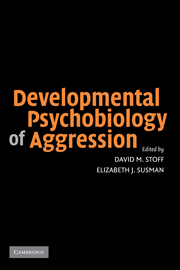Book contents
- Frontmatter
- Contents
- Foreword
- INTRODUCTION
- PART I PLASTICITY
- PART II BIDIRECTIONALITY
- PART III GENE–ENVIRONMENT INTERACTIONS
- 10 Toward an Integrative Account of the Development of Aggressive Behavior
- 11 How Gene–Environment Interactions Shape the Development of Impulsive Aggression in Rhesus Monkeys
- CONCLUSION
- Author Index
- Subject Index
- References
11 - How Gene–Environment Interactions Shape the Development of Impulsive Aggression in Rhesus Monkeys
Published online by Cambridge University Press: 14 July 2009
- Frontmatter
- Contents
- Foreword
- INTRODUCTION
- PART I PLASTICITY
- PART II BIDIRECTIONALITY
- PART III GENE–ENVIRONMENT INTERACTIONS
- 10 Toward an Integrative Account of the Development of Aggressive Behavior
- 11 How Gene–Environment Interactions Shape the Development of Impulsive Aggression in Rhesus Monkeys
- CONCLUSION
- Author Index
- Subject Index
- References
Summary
INTRODUCTION
Professor Robert B. Cairns was a giant in the field of developmental science. His theoretical vision and his empirical rigor and persistence drove a lifelong research and academic career that uniquely helped shape this emerging, dynamic interdisciplinary field. He was a remarkable teacher, researcher, and scholar who profoundly influenced countless students and colleagues and whose legacy will long be with us.
I first got to know Bob Cairns during a mutual stint at the Center for Interdisciplinary Studies (ZIF) at the University of Bielfeld in Germany during the fall and winter of 1977–78. We were both at the ZIF as part of a 9-month-long program entitled “Early Development in Animals and Man” organized by the late ethologist Professor Dr. Klaus Immelmann, who had brought together a group of prominent researchers, representing a wide range of disciplines, who studied developmental phenomena both in humans and in a variety of other mammalian and avian species. I had known about Bob Cairns and his research since my very first days in graduate school at the University of Wisconsin – at that time Jim Sackett was telling all the graduate students at the Primate Laboratory about this guy in Indiana who hauled sheep to his lab in back of his station wagon in order to run studies that demonstrated the power of contiguity conditioning in establishing social bonds.
- Type
- Chapter
- Information
- Developmental Psychobiology of Aggression , pp. 252 - 268Publisher: Cambridge University PressPrint publication year: 2005
References
- 10
- Cited by



